Energy & Commodities
Looking at the charts of crude oil, we clearly see that the major factor, which has driven the price of light crude in the recent weeks was the uncertainty around Syria. At the beginning of the previous week, crude oil began to drop after Russia offered to help put Syria’s chemical weapons under international control. Although the U.S. President Barack Obama said that he will still continue efforts to convince politicians to back military action, Russia’s proposal raised the chance that a U.S. military strike would be delayed or averted. In the following days, we saw two-day small bounce up in crude oil prices as investors worried about whether diplomatic efforts to eliminate Syria’s chemical weapons would avert military action that could disrupt oil supplies from the Middle East. These diplomatic efforts intensified as Russia warned that a U.S. strike could unleash extremist attacks and carry the country’s bitter civil war beyond Syria’s borders. However, this improvement was only temporary and crude oil slipped on Friday as the United States and Russia worked on a plan for Syria to surrender its chemical weapons.
On Saturday, U.S. Secretary of State John Kerry and Russian Foreign Minister Sergei Lavrov agreed to back a nine-month U.N. program to destroy Syrian President Bashar al-Assad’s chemical arsenal. In this way, the U.S. agreed to call off military action against Syria in a deal with Russia. It’s not hard to guess how this event affected oil prices. Today, crude oil has lost over 2% and is trading below $107 a barrel once again.
Once we know the situation around Syria, let’s move to the most important event of the current week – the Federal Open Market Committee meeting. FOMC is meeting for two days from Tuesday with expectations high that policymakers will decide to reduce the monthly $85-billion bond purchases. On a side note, we recently published a detailed analysis (in Sep Market Overview report) of 8 ways in which the situation could evolve based on what the Fed will do regarding the QE program and the way it is announced.
Earlier this month, the weaker-than-expected U.S. payroll numbers for August raised doubts about whether the Federal Reserve will start paring its massive stimulus and resulted in higher prices of light crude. On Friday we saw similar price action as the weak consumer sentiment and retail sales data bolstered the view that Fed policymakers will slow an exit from the U.S. central bank’s bond-buying program.
What will be the decision? By how much the central bank will cut its monthly asset purchase program? What impact will it have on the markets? Will it trigger a further rally in crude oil or a decline? We’ll get answers these questions on Wednesday. Meanwhile, let’s move on to the technical part of our Oil Update. Just like a week ago, we take a look at the charts from different time perspectives to have a more complete picture of the current situation in the oil market.
Let’s start with a look at the monthly chart of light crude (charts courtesy by http://stockcharts.com).
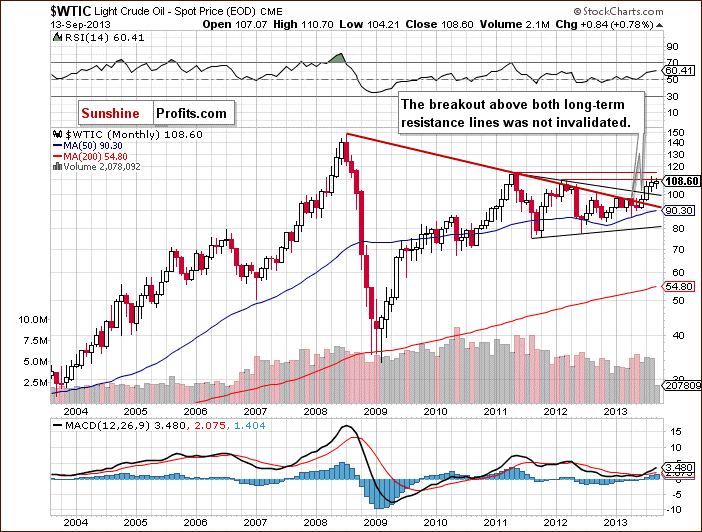
Looking at the above chart, we see that the situation hasn’t changed much. Light crude still remains above the two long-term declining resistance lines: one of them (bold red line) is based on the July 2008 and the May 2011 highs, and the second one is based on the September 2012 and March 2013 highs (the upper black line).
From this perspective the picture is bullish and the breakout above these two long-term declining resistance lines hasn’t been invalidated.
Now, let’s zoom in on our picture of the oil market and see the weekly chart.
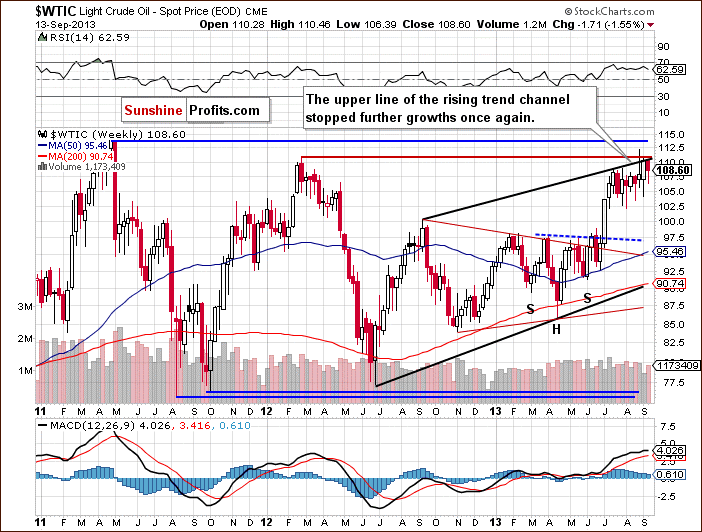
Quoting our last Oil Update:
(…) crude oil reached the strong resistance zone based on the March 2012 top and the upper border of the rising trend channel once again.
Taking the above into account, we should consider two scenarios. If the buyers manage to break above this strong resistance zone, the first price target will be close to the May 2011 top. However, if they fail, history will likely repeat itself and the price of light crude will come back to the consolidation range.
On the above weekly chart, we see that light crude started the previous week above $110 per barrel, but the strong resistance zone stopped the rally once again. Oil bears quickly noticed the opportunity to go short and triggered a corrective move, which pushed the price of crude oil slightly above $106. Despite this drop, light crude rebounded in the following days and closed last week above $108 per barrel.
From this point of view, the situation is somewhat mixed, but with a bullish bias. On the one hand, crude oil still remains slightly below the May 2011 top, which is a bullish factor. On the other hand, there was a third unsuccessful attempt to break above this level, which resulted in a decline to the consolidation range, and such price action doesn’t look so bullish.
Now, let’s check the short-term outlook.
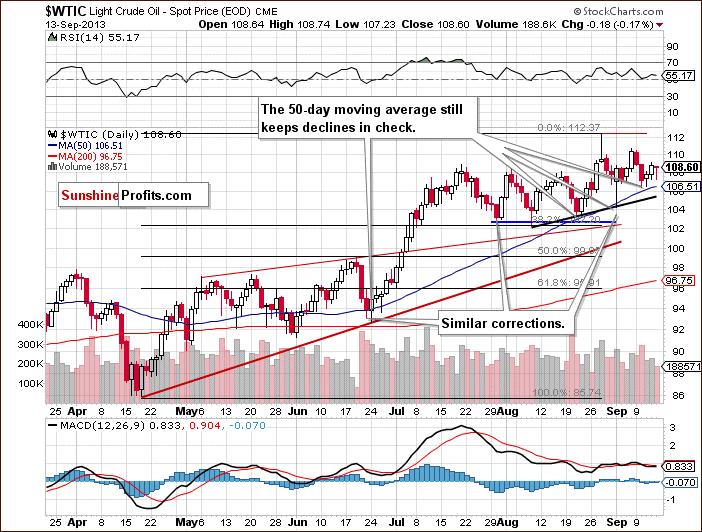
On the above chart we see that the situation has deteriorated since our last Oil Update was published. Since the beginning of the previous week the price of light crude has dropped and reached below $107 per barrel. Although, oil bears tried to push the price below this level on Wednesday, their attempt failed and crude oil rebounded above $109 in the following days. Last session of the week wasn’t so good, but oil bulls didn’t give up and pushed the price of light crude from its daily low to over $108 per barrel.
As you see on the daily chart, slightly below weekly low there is the 50-day moving average, which stopped the decline in June and, again, at the end of August. In both previous cases this moving average encouraged buyers to act, which resulted in sharp rallies in the following days. Please note that we also saw similar price action at the beginning of September. If history repeats itself, the moving average will likely stop a downward move in the coming days.
At this point it’s worth mentioning that the current correction is still shallow and smaller than the previous one (from the August 28 top to the September 3 low), which is a bullish factor. What’s interesting, even if the price of crude oil drops below the weekly low (to about $103), both corrections will be similar and the uptrend will not be threatened.
Where are the nearest support levels? The first is the 50-day moving average (currently at $106.51). The second one is the Tuesday low at $106.39. The third one is the rising line based on the August lows (close to $105.36). The next one is a zone (between $102.22 and $103.50) based on the bottom of the previous corrective move (the August 21 low) and the August low. In this area, there is also the 38.2% Fibonacci retracement level, which reinforces this support zone.
Summing up, although there was a downward move at the beginning of the previous week, which took the price of light crude slightly above $106, technically, the short-term outlook is still bullish. The uptrend is not threatened at the moment, because the recent decline was shallow and smaller than the previous one.
Once we know the current outlook for crude oil, let’s examine the NYSE Arca Oil Index (XOI) once again to find out what the current outlook for the oil stocks is and to check if they confirm or invalidate the above analysis of the crude oil market.
Let’s start with the long-term chart.
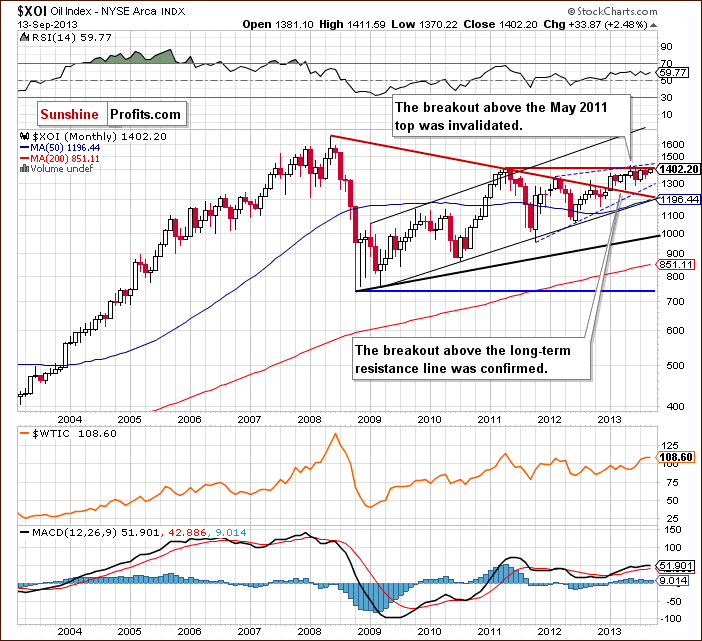
On the above chart, we see that the situation hasn’t changed much and all of what we wrote in our last Oil Update is still up-to-date today.
(..) we’ve been seeing a consolidation in the recent months and the NYSE Arca Oil Index is trading between the July top and the July low.
The XOI remains quite close to the May 2011 top and it’s still above the previously-broken long-term declining resistance line based on the 2008 and the 2011 highs and the breakout hasn’t been invalidated. The oil index also remains in the range of the rising trend channel.
Taking the abovementioned observations into account, the situation is still bullish.
Let’s take a closer look at the weekly chart.
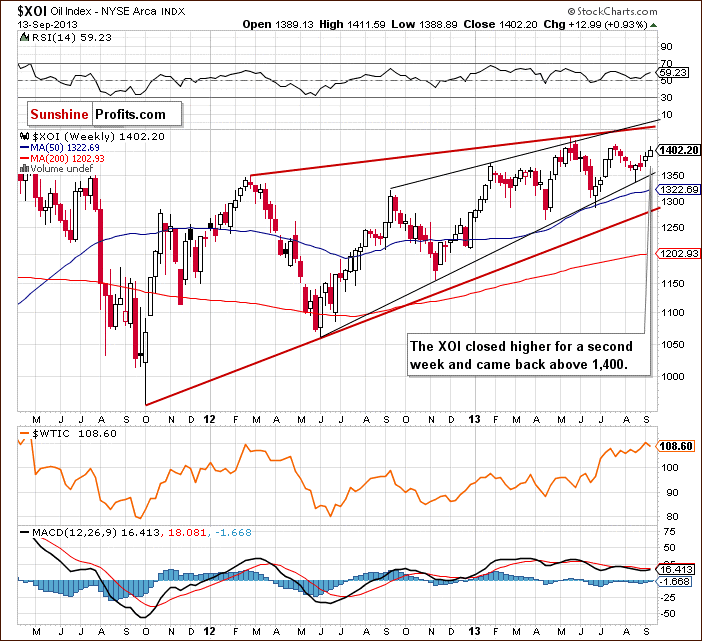
Looking at the above chart, we see that the oil stock index continued its upward move in the previous week and climbed above 1,400. In this way the XOI moved away from the medium-term support line. Keep in mind that this strong support line (marked in black) stopped the decline in June, which resulted in a rally in the following weeks.
Despite the recent growth, we should still keep an eye on the above-mentioned support line, because it is also the lower border of the rising wedge. As you know, this is a bearish pattern and if buyers fail and XOI moves below the short-term support line, it will likely lead to a decline which may take the oil index at least to the lower medium-term support line (the red one).
The medium-term uptrend is not currently threatened, and the situation remains bullish.
What about the relationship between light crude and the oil stocks?
When we take a look at the above chart and compare price action in both cases, we clearly see that oil stocks were stronger in the previous week, as they closed higher for a second week. At the same time light crude close the whole week below the closing level of September 6, 2013. Additionally, light crude still remains below the strong resistance zone based on the March 2012 top and the upper border of the rising trend channel.
Now, let’s turn to the daily chart.
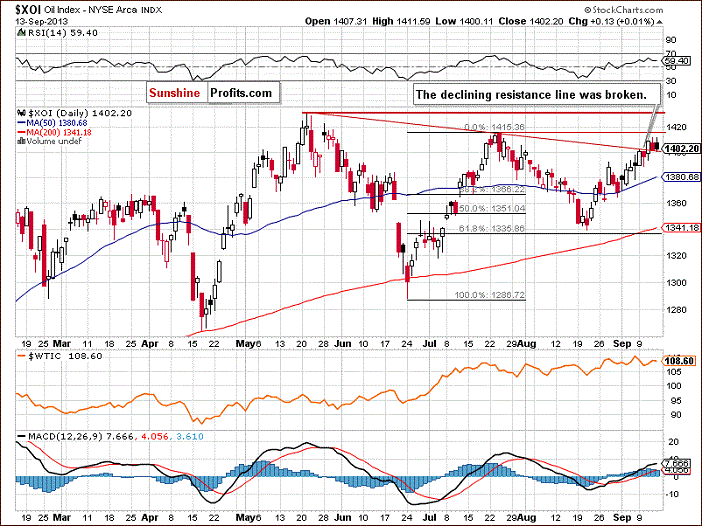
As you see on the above chart, the 50-day moving average stopped further declines at the end of August. This strong support encouraged investors to push the oil index higher, which resulted in an increase above the 61.8% Fibonacci retracement level (based on the entire July-August decline). As we wrote in our previous Oil Update, the next resistance level was the declining line based on the May and July highs (currently close to the 1,404 level).
On the above daily chart we see that oil bulls managed to push the oil index above the previously-mentioned declining line based on the May and July highs. In this way the last resistance level below the July top was broken.
In this case, the next target for buyers is the July peak, and then the May top.
The nearest support is around 1,393 (the September 11 low), the second one is at the 50-day moving average (currently at 1,380.68). The next support zone is based on the August 27 and August 30 lows (1,361-1,364), and a further one is based on the August 21 bottom and the 61.8% retracement level (1,338-1,339).
Now, let’s comment on the relationship between the WTI and the XOI in the short term. Despite the negative divergences at the beginning of the previous week, the second half looked pretty much the same in both cases and we saw declines.
Summing up, from the long- and medium-term perspectives the outlook for oil stocks remains bullish and the uptrend is not threatened at the moment. Taking into account the relationship between light crude and the oil stock index, we can conclude that the oil stocks have been outperforming oil since our first Oil Update was published.
Speaking of relationships, let’s take a closer look at the chart below and check the link between crude oil and gold. Has it changed in the recent days? Let’s examine the daily chart.
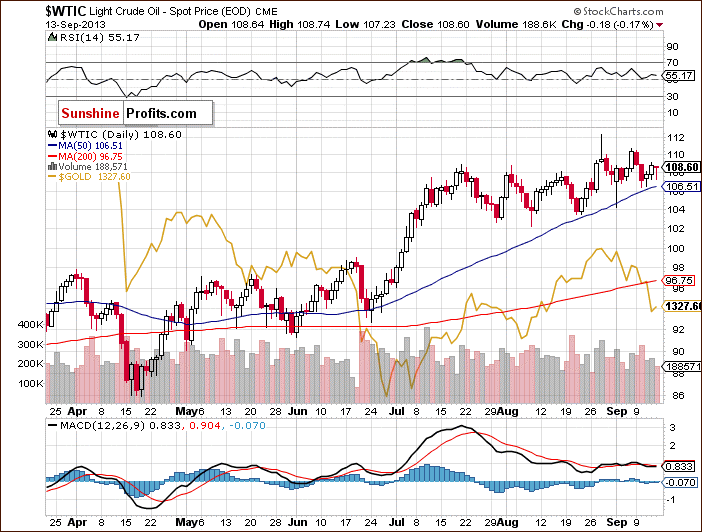
Quoting our last Oil Update:
(…) crude oil was trading in the narrow range between the Tuesday’s bottom and top. What’s interesting, at the same time gold declined once again. In other words, the consolidation in light crude triggered another move lower in gold.
Last week we saw similar price action, but in this case, the negative divergence was even more visible. In the first half of the previous week both commodities declined. However, after this downward move light crude rebounded in the following days and erased over 61.8% of its decline. What did happen with gold at the same time? The yellow metal extended its decline and dropped to a five-week low slightly above 1,300 an ounce.
Taking the above into account, it’s worth taking a closer look at the medium-term outlook for gold.
Let’s turn to the weekly chart of the yellow metal.
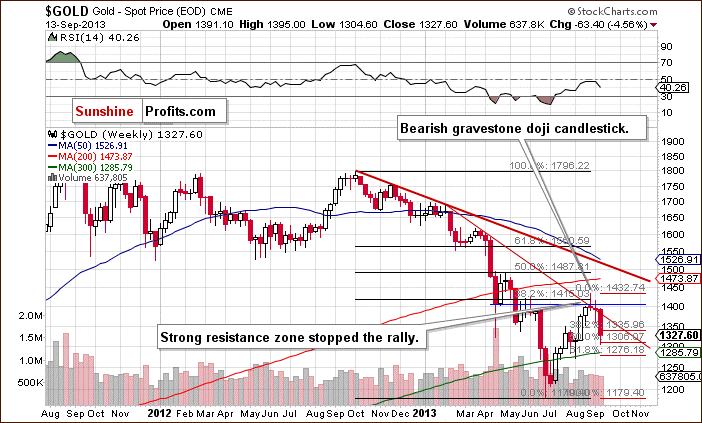
In our last Oil Update we wrote:
(…) the medium-term situation seems quite bearish and if gold drops below the declining resistance line based on the October 2012 and February highs the outlook will be even more bearish.
As you see on the above chart, after gold’s attempts to move above the strong resistance zone failed and the breakout was invalidated, the yellow metal dropped below the abovementioned declining resistance line and accelerated the decline. On Friday, gold reached the 50% Fibonacci retracement based on the June-August rally. In this way, the shiny metal lost almost 6% for the week. It is gold’s biggest weekly loss since June.
Summing up, taking the long and medium-term relationship between light crude and the oil index into account, we can conclude that the oil stocks have been outperforming oil since our first Oil Update was published. In the past, we saw negative divergences between WTI and the XOI many times. In the previous week, the oil index closed higher for a second week and broke above important resistance. Meanwhile, crude oil erased only over 61.8% of its last week’s decline, which confirms weakness of oil in relation to oil stocks.
Looking at the relationship between crude oil and gold, we noticed another negative divergence.Although both commodities declined in the first half of the week, the second half was quite different. As we previously wrote, after this downward move light crude rebounded in the following days and erased over 61.8% of its decline. Meanwhile, the yellow metal extended its decline and dropped to a five-week low. Additionally, the recent decline in crude oil is still smaller than the previous one and the uptrend is not threatened at the moment. At the same time, the downtrend in gold remains in place.
Taking this into account, it seems that the short-term link between the yellow metal and crude oil will wane even more in the coming weeks.
ST outlook: bullish
MT outlook: bullish
LT outlook: bullish
Thank you.
Nadia Simmons
Sunshine Profits‘ Contributing Author
Gold Trading Tools and Analysis – SunshineProfits.com
* * * * *
Disclaimer
All essays, research and information found above represent analyses and opinions of Nadia Simmons and Sunshine Profits’ associates only. As such, it may prove wrong and be a subject to change without notice. Opinions and analyses were based on data available to authors of respective essays at the time of writing. Although the information provided above is based on careful research and sources that are believed to be accurate, Nadia Simmons and his associates do not guarantee the accuracy or thoroughness of the data or information reported. The opinions published above are neither an offer nor a recommendation to purchase or sell any securities. Nadia Simmons is not a Registered Securities Advisor. By reading Nadia Simmons’ reports you fully agree that he will not be held responsible or liable for any decisions you make regarding any information provided in these reports. Investing, trading and speculation in any financial markets may involve high risk of loss. Nadia Simmons, Sunshine Profits’ employees and affiliates as well as members of their families may have a short or long position in any securities, including those mentioned in any of the reports or essays, and may make additional purchases and/or sales of those securities without notice.

It’s tempting to think that all big oil companies are the same. They trade more or less in line with crude prices–with little to differentiate one from another for investors.
But in fact, each has its own distinct personality. That makes a huge difference to value creation. Oxy, for instance, is one of the best exploiters in the business. They can wring value from a mature field that few other firms would see.
Companies like Shell tend to lead through innovation. Ditto Statoil. And we got a good example of that DIY spirit this month.
 Statoil announced that it wants to revolutionize power supply for offshore oil production. The major has signed a JV with power and automation provider ABB to develop a concept called “the subsea factory”.
Statoil announced that it wants to revolutionize power supply for offshore oil production. The major has signed a JV with power and automation provider ABB to develop a concept called “the subsea factory”.
This basically involves building industrial complexes on the ocean floor. Pumps, motors and compressors all located below the water, to make them more stable and cost-efficient in servicing production platforms.
The new JV is aimed at solving one major piece of this puzzle: power supply. Statoil and ABB will jointly work on a solution where a single power cable can be run to a subsea site, and then split off to power individual pumps and other machines. Currently, each unit requires its own dedicated line–which adds a lot of cost.
Statoil has said it believes this technology is critical to economically developing remote, deepwater fields in places like the Arctic.
This is the kind of thinking that differentiates big companies. Some are sitting and waiting for the next big find. Others are trying to manufacture it–making known fields more attractive by changing the game in terms of exploration or production technology.
It’s too early to tell if the subsea factory will be a success. But it’s the right kind of thinking.
Here’s to moving forward,

“U.S. Manufacturing Renaissance is Fact not Fiction”
 QUESTION: Is there a “manufacturing renaissance in the USA.”
QUESTION: Is there a “manufacturing renaissance in the USA.”
ANSWER: Yes. This is developing for two primary reasons. First: the 2011 law that has blocked Americans from starting businesses overseas. Second: many companies including auto manufacturers who rushed to Mexico to manufacture cars are coming back. Ford no longer employs anyone at its Hofu Plant in Japan and the Cuautitian Plant in Mexico both opened in 1981.
Clearly, there is plenty of proof to indicate that there is rising factory output, strong manufacturing production gains, and lower labor costs for the first time in a long-time given the less militant unions that chased jibs away. American workers are more attractive than ever before. For a major Japanese auto manufacturer in the 90s, I was asked to explain how the American plant had higher productivity numbers the a similar plant in Japan. I visited the plant and discovered they employed people who had been in Detroit and lost their jobs thanks to the unions. They moved to California and worked non-union. Productivity rose, they were more happy, less confrontational, and had outperformed the Japanese. The whole thing was the union created confrontation out of everything so the perception that American workers were lazy was actually wrong.
Add to this the natural gas boom underway in the U.S., which many believe will lower energy costs for U.S. manufacturers dramatically, and what you have is a resurgence of the manufacturing sector that has been shrinking as a percentage of the economy for several decades thanks to unions. The USA is probably the most competitive in the world on a global basis. This is also caused by much higher taxes in Europe the will not get any better. The downside, USA needs taxes and we will see rising taxes that will destroy thus new manufacturing renaissance.
Nonetheless, as in all things, the U.S. “manufacturing renaissance” is also cyclical in addition to these structural changes. Therefore, the sector is doing as well as would have been predicted under any circumstances at this point in an economic recovery, however, that provides the incentive to return. Without the cyclical boom in the economy, the manufacturing would not return home. Those who try to downplay this trend as purely cyclical, are clearly speaking from their ivory towers and lack the hands-on contacts that I have had over the years. When the Euro was forming, we developed the strategies for Japanese companies needing to open in Europe. We looked at labor costs, taxes, and currencies. We put those who did not need skilled labor in Ireland and manufacturers in Britain. We were called in to Mercedes and met with the board of director at Daimler Bends. So we participated directly in this decision making process. This is not what I “think” foes on – it is what goes on.
U.S. Manufacturing Renaissance is Fact not Fiction. The question is when will taxation kill it? What destroyed American manufacture is perspective. A woman was very demanding and confrontational. Her husband split and eventually met a girl 20 years younger. The wife then says he left her for the “young girl” he met after the break up. That is the explanation she prefers because there is no responsibility on her part. This is the same problem. It is better to say it was the greed of manufacturers seeking low costs rather than to say unions became too confrontational with no sense of competitiveness and politicians kept raising taxes that made the products too expensive and uncompetitive. It is a two-way street.
…..read more postings at Armstrong Economics HERE

The man dubbed by Barron’s as the “technician’s technician” Martin Pring of Pring.com shares why he thinks that a commodity bull market is about to start again.
In June, I discussed “Are commodity prices about to explode?” The question mark was there because a lot of ingredients were in place for a major rally, but I also pointed out that we really needed confirmation from some of the key averages.
Now I am going to remove the question mark, because two months later, a substantial number of indicators are crying “commodity bull market.” Take a pinch of salt with the explode part of the headline because there are no known techniques for consistently forecasting the character of a forthcoming price move. I am not ruling it out, merely forecasting that in one way or another prices are likely to be substantially higher by year-end.
Commodity indexes are a disparate bunch, and some have already experienced tentative breakouts while others look set to. What’s really interesting is that traders in other markets, which often anticipate commodity rallies, have already started to discount inflationary times ahead. In effect, they are telling commodities that it’s time to get moving.
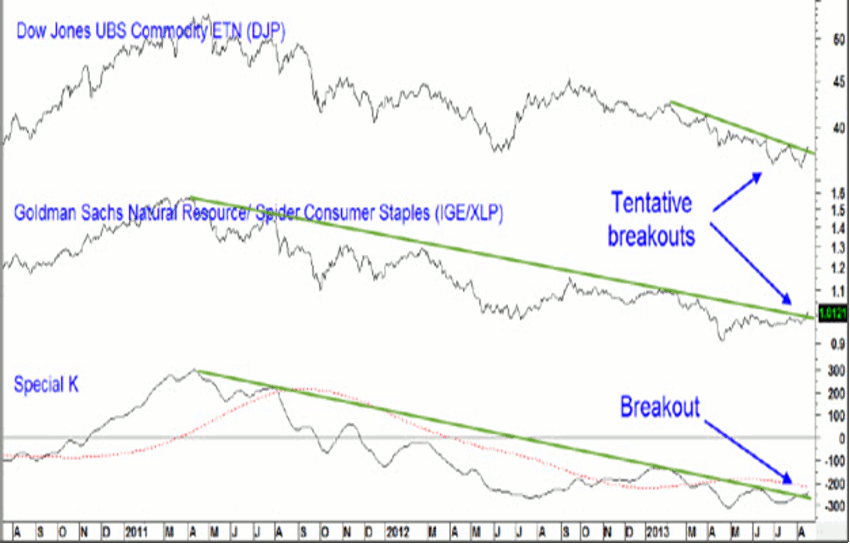
….for a larger chart view & 3 more Charts & commentary go HERE

The price of oil hovered around $107 a barrel on Wednesday, a day after President Barack Obama said he asked U.S. lawmakers to postpone a vote authorizing the use of military force against Syria.
By early afternoon in Europe, benchmark oil for October delivery was down 14 cents to $107.25 a barrel in electronic trading on the New York Mercantile Exchange. On Tuesday, the contract fell $2.13, or 1.9 percent, to close at $107.39 a barrel on the Nymex.
Obama, in a televised speech to the nation late Tuesday, said he wanted to give Syria a chance to turn over its chemical weapons before he asks Congress for consent to intervene in the country’s civil war.
Oil prices have been at elevated levels for two weeks following Obama’s call for action against the government of Syrian President Bashar Assad in retaliation for what the White House says was a deadly chemical weapons attack against civilians last month.
Syria’s surprise announcement Tuesday that it would accept a Russian plan to turn over its chemical weapons stockpile raised the possibility of a resolution to the standoff between Obama and Assad and lowered tensions in oil markets.
“In view of the abating geopolitical risks, oil prices are likely to fall further, for the oil price level is still too high from a purely fundamental perspective,” analysts at Commerzbank in Frankfurt said in a report, listing ample global supplies and strong production by OPEC members as factors weighing on prices.
While prices edged off a recent two-year high as the likelihood of a Syrian strike diminished, some analysts predicted prices would remain high for the time being.
 “Although recent political events have decreased the probability of an international military intervention in Syria, we still see the risks to oil prices as skewed to the upside over the next several months,” said analysts at Goldman Sachs in an email commentary.
“Although recent political events have decreased the probability of an international military intervention in Syria, we still see the risks to oil prices as skewed to the upside over the next several months,” said analysts at Goldman Sachs in an email commentary.
Market fluctuations appeared to support this view, as the Nymex contract fell as low as $106.53 earlier Wednesday before traders began buying again, taking advantage of the dip and betting on the situation in Syria to keep supporting prices.
Syria is not a major oil producer, but oil traders say the possibility of a wider conflict could interrupt production and shipping routes in the Middle East and cause prices to rise.
A draw of 2.9 million barrels in U.S. crude stocks last week, as reported late Tuesday by the American Petroleum Institute, also sustained prices. Data from the Energy Department’s Energy Information Administration — the market benchmark — will be out later Wednesday.
Brent, the benchmark for international crudes, was up 53 cents to $111.78 a barrel on the ICE Futures exchange in London.
In other energy futures trading on Nymex:
— Wholesale gasoline rose 0.26 cent to $2.7383 per gallon.
— Natural gas lost 1.7 cents to $3.567 per 1,000 cubic feet.
— Heating oil added 1.45 cents to $3.0813 per gallon.
___
Pamela Sampson in Bangkok contributed to this report.
….read more at Euro Pacific Capital HERE












